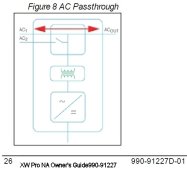Enphase Gen 3:
Enphase Gen3 not backward compatible with Gen2.
You cannot upgrade your existing system controller/batteries with the new ones and you cannot reuse existing batteries with a Gen3 system controller!
So let's get the Schneider XW AC coupling to work.
AC Calibration:
AC inverter voltage can be changed in:
select Inverter -> Configuration -> Advanced -> AC Calibration
Same password as for setting grid profiles.
Changed my AC voltage from 238V to 248V.
Be vary careful and disconnect all AC loads, do not type in a value that may be off too much, use the spinners to up/down voltage.
Won't change much with increments less than 100 points.
Enphase Gen3 not backward compatible with Gen2.
You cannot upgrade your existing system controller/batteries with the new ones and you cannot reuse existing batteries with a Gen3 system controller!
So let's get the Schneider XW AC coupling to work.
AC Calibration:
AC inverter voltage can be changed in:
select Inverter -> Configuration -> Advanced -> AC Calibration
Same password as for setting grid profiles.
Changed my AC voltage from 238V to 248V.
Be vary careful and disconnect all AC loads, do not type in a value that may be off too much, use the spinners to up/down voltage.
Won't change much with increments less than 100 points.





